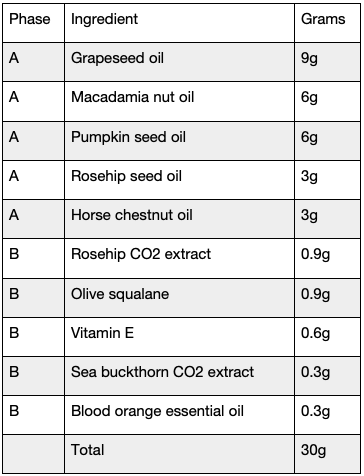Active ingredient-packed serums are available in a wide range of forms and there are many ways to make a serum.
Here, Brooke Medhurst, Formulation Tutor at Formula Botanica, the organic cosmetic science school, provides her guidance for making an oil serum called Autumn Sunset Facial Serum, which is inspired by the changing of the seasons.
Over to the expert...

Brooke Medhurst,
Formula Botanica
Serums come in different forms ranging from liquid sprays and thick gels to pressed balms and rich oils.
Whatever their format, serums are essentially products composed of a high concentration of active ingredients.
These are chosen specifically to ‘pack a punch’ in delivering results on a single skin care issue, as well as enhancing the overall effectiveness of your skin care routine.
The main benefit of including a serum in your routine is that all its ingredients are focused on a single goal.
So, when choosing a serum, it is important to research how a particular product works for you as there are no one-stop-shop serums for all your skin care needs.
Here, we show you how to create a serum to protect and nourish your skin as the colder months approach. Our formula is for a rich oil serum aimed at nourishing the skin and supporting its barrier function.
These effects are achieved by reducing transepidermal water loss (TEWL), which is where the skin is stripped of its moisture to leave it feeling dry and looking less radiant.
Generally, a serum is used daily after cleansing and toning and before you apply a moisturiser. However, as a rich, oil-based formula, our serum is best used at the end of your skin care routine. Oil serums are often used at night under a sleeping mask or heavier night cream.
There are endless ways to create an oil serum, but great products are often born of a single idea.
First, choose your theme. This can be inspired, for example, by particular ingredients or a colour you wish to use, while, of course, fitting within the overriding functional aim of your serum. Pick a theme and add other ingredients that align with your serum’s purpose.
This oil serum was inspired by a beautiful autumn sunset, which is apt as the scene heralds the changing seasons and also our need to protect our skin from the onset of the northern hemisphere’s cooler weather.
We are using ingredients harvested in autumn and which give the serum a vibrant, seasonal orange colour. You really can take inspiration from around you.
An oil serum is composed entirely of oil-soluble (lipophilic) ingredients such as carrier oils, CO2 extracts, antioxidants, oil-based vitamins and actives.
The base of the product consists of carrier oils and you can add your chosen actives such as botanical CO2 extracts, essential oils or ingredients such as olive squalane or vitamin E.
Try to use carrier oils that reinforce the aims of your product. Perhaps research and trial new oils coming onto the market, exploring their potential for your serum and to differentiate your product.
Formulation: Autumn Sunset Facial Serum
Here is my formulation for an autumn sunset facial oil designed to protect skin from cold, moisture-wicking weather and boost its radiance.

Method of manufacture
1. Ensure that your workspace is fully cleaned and prepared for formulation, your equipment is clean and sterile and you are wearing the appropriate personal protective equipment.
2. Weigh out your carrier oils (phase A) into a beaker and stir together with a glass rod.
3. Weigh your active ingredients (phase B) into the same beaker and stir well.
4. Transfer the serum to a suitable container with a pump or dropper and label your product including date and batch number.
5. Store in a cool place away from direct sunlight.
Formulation tips
• Make sure you stir the product well to disperse the ingredients evenly. Keep stirring until you no longer see swirls of oil in your beaker. The end product should be clear and even in colour.
• Using an attractive shaped and/or coloured glass serum bottle with a pump or dropper attachment enhances the luxury feel of the product. Opaque and darker glass also helps prolong the shelf life of your oils.
• Use a pipette to weigh out the oils and extracts into your beaker as it is easy to pour too much out if decanting directly from suppliers’ containers.
• Make sure you add an antioxidant to your formulation to protect your oils against rancidity. We added vitamin E to help perform this role.
